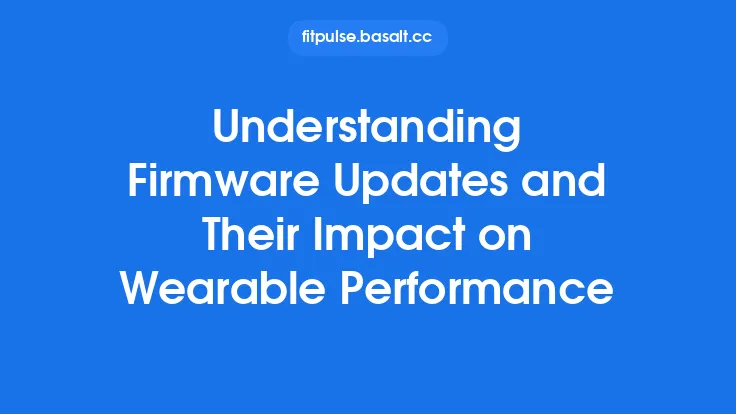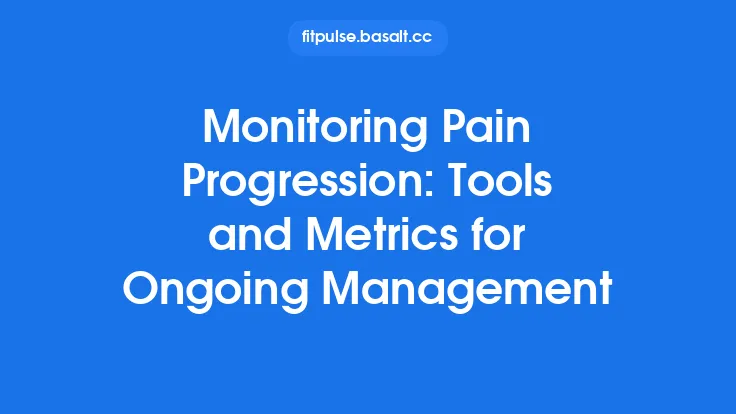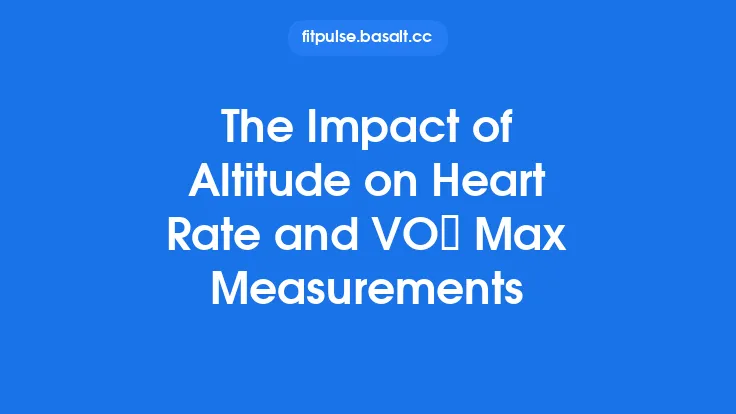Understanding stress monitoring begins with recognizing that stress is not merely a psychological feeling; it is a measurable physiological state that can be quantified, tracked, and leveraged to fine‑tune fitness programs. Modern fitness technology has turned what was once an abstract concept into a concrete set of data points that athletes, coaches, and everyday exercisers can use to make smarter decisions about training intensity, recovery, and overall health. This article delves into the core metrics that stress‑monitoring devices capture, explains how those metrics are derived, and outlines their practical implications for fitness performance.
What Is Stress Monitoring?
Stress monitoring refers to the continuous or periodic assessment of the body’s autonomic response to internal and external stimuli. The autonomic nervous system (ANS) regulates involuntary functions such as heart rate, respiration, and hormone release. When the body perceives a challenge—whether a heavy lift, a demanding work deadline, or an emotional upset—the ANS shifts toward a “sympathetic” (fight‑or‑flight) state, releasing catecholamines (adrenaline, noradrenaline) and cortisol. Conversely, a “parasympathetic” (rest‑and‑digest) state promotes recovery and regeneration.
Fitness‑focused stress monitoring aims to capture the balance between these two branches of the ANS, providing a snapshot of how “stressed” the body is at any given moment. By translating physiological signals into readable metrics, devices enable users to see whether their nervous system is primed for high‑intensity work, needs a lighter session, or is still in recovery mode.
Physiological Signals Used in Stress Tracking
| Signal | How It Is Measured | What It Indicates |
|---|---|---|
| Heart Rate Variability (HRV) | Inter‑beat intervals captured via photoplethysmography (PPG) on the wrist, chest strap ECG, or dedicated finger sensors | The variation between successive heartbeats; higher HRV generally reflects greater parasympathetic activity and better recovery capacity. |
| Electrodermal Activity (EDA) | Conductivity sensors on the skin (often on the wrist or finger) detect sweat‑induced changes | Sympathetic nervous system activation; spikes in EDA correspond to acute stress responses. |
| Resting Heart Rate (RHR) | Continuous heart‑rate monitoring, usually averaged over a night or a morning period | Elevated RHR can signal accumulated fatigue or insufficient recovery. |
| Respiratory Rate (RR) | Chest‑strap accelerometers, PPG‑derived algorithms, or dedicated respiration belts | Stress often accelerates breathing; irregular patterns may indicate heightened arousal. |
| Skin Temperature | Thermistors placed on the wrist or ear lobe | Peripheral vasoconstriction (lower skin temperature) is a sympathetic response; temperature trends can complement other stress markers. |
| Cortisol (Indirect) | Some advanced wearables infer cortisol trends through a combination of HRV, EDA, and sleep data, though direct measurement requires saliva or blood. | Provides a hormonal perspective on chronic stress, but most consumer devices estimate rather than directly measure cortisol. |
Each signal contributes a piece of the stress puzzle. The most common and reliable metric for everyday fitness users is HRV, because it can be captured accurately with a wide range of wearables and has a robust body of scientific validation.
Key Metrics in Stress Monitoring
- Stress Score / Stress Index
- Definition: A composite number (often 0–100) derived from weighted inputs such as HRV, EDA, and RHR.
- Interpretation: Lower scores indicate a relaxed, recovery‑ready state; higher scores suggest acute sympathetic dominance.
- Use Cases: Quick daily check‑ins to decide whether to push a hard workout or opt for a lighter session.
- HRV Time‑Domain Measures
- RMSSD (Root Mean Square of Successive Differences): Sensitive to parasympathetic activity; the most common HRV metric displayed on consumer devices.
- SDNN (Standard Deviation of NN intervals): Reflects overall variability; useful for longer‑term trends.
- Interpretation: Higher RMSSD values are generally favorable, indicating a resilient nervous system.
- HRV Frequency‑Domain Measures
- LF (Low‑Frequency) Power: Mixed sympathetic and parasympathetic influence.
- HF (High‑Frequency) Power: Primarily parasympathetic.
- LF/HF Ratio: Historically used to estimate sympathovagal balance, though its reliability in short‑term recordings is debated.
- Interpretation: A lower LF/HF ratio typically points to a more relaxed state.
- Electrodermal Activity Peaks
- Number of Peaks per Minute: Frequency of sudden EDA spikes.
- Peak Amplitude: Magnitude of each sympathetic burst.
- Interpretation: Frequent, high‑amplitude peaks correlate with moments of acute stress (e.g., high‑intensity intervals, mental pressure).
- Resting Heart Rate Trends
- Baseline RHR: Established over a 2‑week period.
- Deviation from Baseline: +5–10 bpm may signal accumulated fatigue.
- Interpretation: Persistent elevation suggests the body is not fully recovering.
- Recovery Time Estimates
- Calculated from HRV and RHR: Some platforms provide a “recovery time” (e.g., “You need 24 h of rest before the next high‑intensity session”).
- Interpretation: Serves as a practical guide for scheduling workouts.
How Stress Metrics Relate to Fitness Performance
| Fitness Aspect | Stress Metric Influence | Practical Insight |
|---|---|---|
| Strength & Power | Acute stress spikes (high EDA, low HRV) can temporarily boost neuromuscular activation, but prolonged sympathetic dominance reduces force output. | Use stress scores to schedule heavy lifts on low‑stress days for maximal strength gains. |
| Endurance | HRV correlates with aerobic capacity; higher HRV often predicts better VO₂max improvements. | Monitor HRV trends to adjust long‑run volume; a dip may warrant a recovery run. |
| Speed & Agility | Rapid sympathetic responses improve reaction time, yet chronic stress impairs coordination. | Short‑term stress spikes can be leveraged for high‑intensity interval training (HIIT); avoid sustained high stress before skill‑focused sessions. |
| Flexibility & Mobility | Elevated muscle tension from sympathetic activation can limit range of motion. | Low‑stress days are optimal for mobility work and yoga. |
| Injury Risk | Persistent low HRV and high resting heart rate are linked to overuse injuries. | Early detection of declining HRV can prompt pre‑emptive deloads. |
In essence, stress metrics act as a “readiness gauge.” When the autonomic balance leans toward parasympathetic dominance, the body is primed for demanding work. When sympathetic activity dominates, the system is either responding to an acute challenge or is fatigued and in need of recovery.
Practical Ways to Use Stress Data in Training
- Daily Readiness Check
- Routine: Measure HRV each morning (preferably upon waking, before caffeine or movement).
- Decision Tree:
- HRV ≥ baseline + 5% → Consider a high‑intensity or strength session.
- HRV within ±5% of baseline → Follow the planned moderate workout.
- HRV ≤ baseline – 5% → Opt for a low‑impact cardio, mobility, or rest day.
- Periodization Adjustments
- Macrocycle Planning: Use aggregated stress scores to identify weeks of high cumulative load. Insert “recovery weeks” when average stress scores exceed a predetermined threshold (e.g., >70 for three consecutive days).
- Microcycle Tweaking: Shift a hard day forward or backward based on the previous night’s HRV.
- Warm‑up Tailoring
- High Stress: Extend warm‑up duration, incorporate dynamic stretching, and include low‑intensity activation drills to counteract muscle tension.
- Low Stress: Shorter, more explosive warm‑ups can be sufficient.
- Post‑Workout Recovery Strategies
- Elevated Stress Post‑Session: Implement active recovery (light cycling, foam rolling) and prioritize sleep hygiene.
- Low Stress Post‑Session: May indicate insufficient stimulus; consider adding a brief finisher or increasing load.
- Mental‑Physical Integration
- Mindfulness & Breathing: Guided breathing exercises (e.g., 4‑7‑8 pattern) can quickly shift the ANS toward parasympathetic dominance, improving subsequent HRV readings.
- Visualization: Mental rehearsal of upcoming lifts can reduce anticipatory stress, reflected in lower EDA spikes.
Common Pitfalls and How to Ensure Accurate Readings
| Pitfall | Why It Happens | Mitigation |
|---|---|---|
| Inconsistent Measurement Timing | HRV fluctuates throughout the day; measuring at different times skews trends. | Choose a fixed time (ideally first thing in the morning) and stick to it. |
| Movement Artifacts | PPG sensors can misread during motion, especially on the wrist. | Use a chest‑strap ECG for the most reliable HRV, or ensure the wrist device is still during measurement. |
| Environmental Temperature Changes | Skin temperature affects EDA and PPG signals. | Allow the device to acclimate for a few minutes before recording; avoid extreme cold or heat. |
| Caffeine, Alcohol, or Medications | These substances alter heart rate and HRV. | Record intake in a training log; consider excluding days with heavy consumption from trend analysis. |
| Over‑reliance on a Single Metric | Stress is multidimensional; focusing only on HRV can miss sympathetic spikes. | Combine HRV with EDA and resting heart rate for a fuller picture. |
| Short Recording Windows | HRV calculations need a minimum of 2–5 minutes of stable data. | Follow manufacturer guidelines; many apps automatically enforce a minimum duration. |
By addressing these common sources of error, users can trust that the data they act upon truly reflects their physiological state.
Choosing the Right Stress Monitoring Tool for Your Needs
| Feature | Entry‑Level Options | Mid‑Range Options | High‑End Options |
|---|---|---|---|
| Sensor Type | Wrist‑based PPG (e.g., basic fitness bands) | Wrist PPG + EDA (e.g., dedicated stress trackers) | Chest‑strap ECG + multi‑sensor suite (HRV, EDA, skin temperature) |
| HRV Accuracy | Moderate (acceptable for trends) | High (validated against ECG) | Clinical‑grade (research‑validated) |
| Battery Life | 5–7 days | 3–5 days (more sensors) | 1–2 days (continuous multi‑sensor) |
| Data Integration | Proprietary app only | Sync with major platforms (Apple Health, Google Fit) | Open API for custom analytics |
| Price Range | $30–$80 | $100–$250 | $300+ |
When selecting a device, consider the following decision points:
- Primary Goal: If you only need a general stress trend, a wrist‑band with reliable HRV is sufficient. For athletes who require precise day‑to‑day variability, a chest‑strap ECG is worth the investment.
- Data Ecosystem: Choose a device that integrates with the training software you already use (e.g., Strava, TrainingPeaks) to avoid data silos.
- Comfort & Wearability: Consistency is key. A device that feels uncomfortable will be abandoned, nullifying its benefits.
- Validation: Look for third‑party validation studies or certifications (e.g., FDA clearance for medical‑grade devices) if scientific rigor is essential.
Integrating Stress Data with Other Fitness Metrics
Stress monitoring does not exist in isolation. When combined with training load, sleep quantity, and nutrition data, it becomes a powerful component of a holistic performance dashboard.
- Training Load + Stress Score: Overlay daily stress scores on a training load graph to spot mismatches (high load + high stress = potential overreaching).
- HRV + VO₂max Trends: A rising HRV alongside improving VO₂max suggests effective adaptation; a falling HRV while VO₂max plateaus may signal hidden fatigue.
- Nutrition Timing: Carbohydrate intake can blunt sympathetic spikes post‑exercise; logging meals alongside stress metrics can reveal nutritional influences on recovery.
- Subjective Wellness Scores: Pair objective stress data with self‑reported mood or perceived exertion to validate the numbers and refine personal thresholds.
By creating a multi‑dimensional view, athletes can make nuanced decisions—such as adjusting interval intensity, scheduling a recovery massage, or tweaking macronutrient ratios—based on a comprehensive understanding of how stress interacts with other performance variables.
Bottom Line
Stress monitoring translates the invisible tug‑of‑war between the sympathetic and parasympathetic branches of the autonomic nervous system into actionable numbers. Core metrics—HRV, electrodermal activity, resting heart rate, and derived stress scores—offer a window into readiness, recovery capacity, and the cumulative impact of training and life demands. When interpreted correctly and integrated with broader fitness data, these metrics empower users to:
- Align workout intensity with physiological readiness.
- Detect early signs of fatigue before performance declines.
- Optimize recovery strategies to sustain long‑term progress.
- Personalize training plans without relying on guesswork.
The technology is now mature enough for everyday athletes to benefit from scientific‑grade insights, provided they follow best‑practice measurement protocols and choose devices that match their goals. By making stress a quantifiable part of the training conversation, fitness enthusiasts can move beyond “how I feel” to “how my body is telling me,” unlocking a higher level of performance and well‑being.




